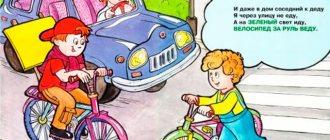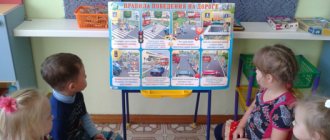If you want
Stay healthy. (Appendix 6.)
Cat: Thank you guys, you know a lot and taught me a lot. I'm interested in you. I realized that it is bad not to know the rules of the road.
Voss: Let's all play the game “Pedestrian
Drivers” together.
(children are divided into 2 groups, “pedestrians” and “drivers”.
On command: “Move!”
The “street” comes to life, vehicles move along the roadway, “pedestrians” walk along sidewalks and crossings .
"Drivers"
must follow the traffic rules,
“pedestrians”
must cross the street correctly.
(Appendix 7)
Voss: - Guys, what is this? ( there is a tall closed
cabinet)
- Look, something is written here.
( reads)
- To find out what is hidden here, you need to repeat the rules of pedestrians.
Children: 1. You only need to walk on the right side of the sidewalk.
2.Do not walk along the roadway.
3. Do not push passers-by when rushing to the bus.
4. You can cross the street in places where there is a pedestrian path.
5. Hold small children by the hand when crossing the street.
6. When crossing the road where there is no traffic light or crossing (streets in rural areas)
You must first look to the left, and when you reach the middle, look to the right.
Voss: Well done, guys. And lo and behold, it appeared......
Children: Traffic light.
(read poetry)
The traffic light is a great help.
Traffic rules, traffic lights, road traffic. Lesson notes, GCD
If you are faced with the task of organizing a thematic lesson or educational activity on studying traffic rules, refer to the positive experience of your colleagues outlined in the publications in this section.
Here you can find plans for conducting and ready-made notes of successfully conducted classes, which contain many valuable ideas and successful pedagogical discoveries. During educational activities, using the conversation and quiz format, supplement and consolidate children’s knowledge about basic road signs, traffic lights, rules for crossing the roadway and behavior on the streets. Develop the ability to solve problematic situations that pedestrians or passengers may find themselves in. Enrich children's active vocabulary and improve their dialogical speech.
He always warns
In color, is it okay to go?
Vos: These are familiar colors: green, yellow, red traffic light colors. They invite you to dance, and I will see how attentive you are.
- if there is a green light ahead, dance more joyfully,
- if yellow - dance on the spot,
— if it’s red, stop! - shake your finger at each other: “you can’t go forward.”
(cheerful music sounds
)
Cat: I'll tell you a secret: I know how to save road signs.
Here I have pictures of road signs. You look at them and name what these signs mean.
(children complete the task ) (Appendix 8.)
Cat: right, and now you need to say the magic words: “Signs, signs! Please respond and come back to us soon!”
(children say these words in chorus)
road signs appear.
Road signs: We are glad, very glad
Didactic games on traffic rules in the senior group
Preschoolers in the older group already know the rules of behavior on the street; they just need to generalize the knowledge. During games, children develop memory, speech skills, observation, and their spatial orientation improves. It is important to develop discipline in older preschoolers and the desire to follow traffic rules in everyday life.
Rod of Knowledge
The game generalizes preschoolers' knowledge about the correct behavior of pedestrians. The teacher divides the students into 2 teams. To practice, you need to take a toy traffic controller’s baton, or make one yourself.
The leader alternately gives the baton to the players of different teams. The player who received the item must remember the rule of safe behavior for pedestrians. You can't repeat yourself. The team that gives the most correct answers wins.
Example answers:
- the pedestrian must walk on the sidewalk;
- when crossing the street you need to look to the left, then to the right;
- in the absence of a sidewalk, it is permissible to walk along the side of the road towards moving cars;
- Crossing the street is permitted when the traffic light is green;
- You cannot play on the road or in its immediate vicinity;
- You must not cross the road when vehicles are approaching.
Safe streets
The purpose of the didactic game on traffic rules is to form an idea of correct walking and wheeled movement along city streets, consolidating knowledge about regulatory signs.
The board game is intended for 2-3 players. For it you need to prepare a playing field with a schematic representation of city streets, figures of people, road signs, cars, traffic lights. You can buy a ready-made board game, or you can find it on the Internet and print it out.
The teacher distributes signs and symbols across the field. Players disassemble figures of people and cars. Characters and vehicles can be completely different. You can come up with any scenarios. For example, a schoolchild returns home after school, or a truck carries groceries to the store.
Players take turns rolling dice to move characters along the street. If this is a pedestrian, then he is moved by as many cells as there are dots on the die. If a cyclist, the number of “steps” is multiplied by 2. If a motorist, multiplied by 3. A player moving in a vehicle can accept passengers and leave the car in the parking lot. In the latter case, he becomes a pedestrian. When a cube hits an underground passage, the player can immediately, in one move, move to the opposite side of the street. And if you get into an area marked as dangerous, you have to skip a move.
Guess the sign
The game improves visual and auditory perception, teaches preschoolers to remember the visual form of a road sign when mentioned verbally. To play, you need to prepare a lotto with images of different signs, as well as blank sheets of paper the size of the pictures.
The game involves 3-6 children. The teacher lays out the lotto in front of each person and distributes paper. Then he reads out a riddle or part of a poem regarding a specific road sign. The players’ task is to understand what sign is being talked about, find it on the lotto, and cover it with a sheet of paper. The winner is the one who covers all the pictures correctly and faster than his opponents.
Driver
The game consolidates knowledge of traffic rules, improves thinking ability and the ability to navigate in space. It is necessary to prepare several options for playing fields depicting streets with infrastructure and regulatory signs. It is important that the fields allow you to play out different situations on the road. A small toy car is also needed.
The teacher gives the student a task consisting of a series of actions. For example, “go to the clinic, then fill up with gas at the bus station, buy groceries at the store on the way home.” The task in the game is to do everything that is said without breaking the traffic rules. The path begins with an image of a garage or parking lot and should end there.
My street
Do-it-yourself didactic games on traffic rules are very interesting; a teacher can make a model of a street with children. For older kindergarteners, this is an extremely exciting activity. It’s good if the model represents a real street on which the kindergarten is located. All traffic lights, zebra crossings, traffic signs, and vegetation are required. We also need figures of vehicles and pedestrians.
At the first stage of the game, children examine the model made, answer the teacher’s questions, pointing with their finger what they mean or putting the characters in a certain place. What are these questions:
- what buildings are located on the street;
- traffic here is one-way or two-way, how many lanes are there on the road;
- is there an intersection on the street, how to cross it correctly;
- where are the pedestrian crossings, how are they marked;
- where pedestrians walk, where cars drive, is it possible to go out onto the roadway;
- how traffic is regulated, where traffic lights are located;
- is there public transport on the street, what is it for, where are the stops;
- what do the road signs on the street mean?
At the second stage of the game, the teacher asks the students to take turns “driving” and “walking” along the street, observing the rules of safe movement. Children who make no mistakes in completing the task receive a prize.
Didactic games on traffic rules in the middle group
In the middle group, it is important to reinforce the rules of safe movement on the street. Children need to be introduced to the main road signs and their meanings, and to be taught proper behavior on the road.
Right or wrong
The teacher places figures of characters and vehicles on the playing field depicting the street. The children's task is to tell whether each character acts correctly or incorrectly, and why. If incorrect, players must correct the actions.
Transport
To play, you need to print out images of vehicles. The teacher reads riddles or excerpts of poetry about a specific vehicle, and the children must guess what they are talking about. Whoever names the correct vehicle first gets its picture. The winner is the player who collects the most pictures.
What applies to the passenger?
The presenter calls out a series of words, and the players must clap their hands when the word refers to passenger transport and passengers. For example: tram, ticket, walk, rest, stop, trip, dancing, seat, plane, swimming, conductor.
Traffic Laws
The didactic game “Road Rules” reinforces preschoolers’ knowledge of how motorists and pedestrians should behave towards each other, what signs and symbols to take into account. You need to prepare cardboard sheets. Glue pictures depicting different situations on the road to one side of each cardboard, and a verbal description to the other.
Children look at the pictures and try to explain the situation depicted: whether road users act correctly, taking into account road signs, symbols and traffic lights. Next, the presenter reads out what is written on the sheets so that the players understand whether they answered correctly.
Answer correctly
To play the game you need to make chips. The teacher divides the players into 2 teams. Each group takes turns asking questions and is awarded a chip for the correct answer. The team that collects the most chips wins. Here are the questions for the game:
- Where do pedestrians go? - on the sidewalk;
- How to behave correctly on public transport? - quiet, calm;
- Where should children play? - in the courtyard;
- What colors does the traffic light light up? – red (stop), yellow (wait), green (go);
- When a pedestrian's light is green, which light is on for the driver? - red;
- What is a person who walks called? - a pedestrian;
- Where does public transport stop? - At the stop;
- Is it possible for a small child to cross the road alone? – no, you need to be with an adult;
- Where is it legal to cross the road? – at traffic lights, along pedestrian and underground passages;
- How to get around the bus? - from behind, when he drives away;
- What kind of transport is there? – passenger, personal, land, underground, sea, air.
What does the traffic controller tell us?
The game requires 3 cards depicting a traffic controller gesturing according to traffic signals. And also 3 mugs: red, yellow, green. The player’s task is to match the image of the traffic controller to the correct color of the traffic light.


